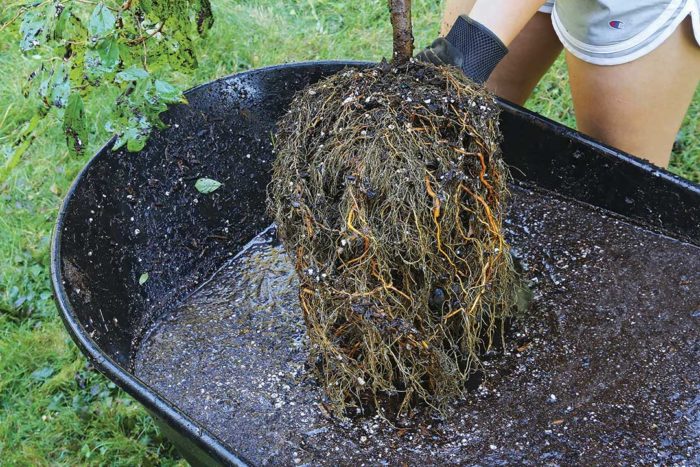
By now you’ve undoubtedly heard fellow gardeners talking about “root washing” their trees, shrubs, or even perennials before planting. The thought of removing all the protective coverings from the root mass may seem counterintuitive or even dangerous. But this method—when performed correctly—will give your plants the best chance of establishing into your gardens and landscapes.
The most common reason container or balled-in-burlap (B&B) plants die after transplanting is that their roots fail to establish in the landscape. In comparison, bare-root stock like roses or fruit trees are more likely to establish, though their initial aboveground growth may be slow. This sluggish top growth is often referred to as “transplant shock,” a term I dislike because it not only sounds bad, but it also suggests that everything has stopped. Nothing could be further from the truth! Newly planted bare-root stock puts its resources into new root growth—not crown growth. And it’s root growth that we need to encourage at transplant. Rather than “transplant shock” let’s call it “root establishment,” because that is exactly what is happening.
So what happens when a container or B&B plant is put into the ground with an intact root ball? New leaves and flowers will continue to form because the roots haven’t been disturbed. That’s not where we want resources going, however, because without root establishment into the landscape soil, the crown will die. It may take months or years, but it will happen. There are finite resources stored in a plant, and they are allocated to whatever tissues need them for growth. Vigorous crown growth reduces the resources sent to the roots, and that’s the very worst thing that can happen to a newly installed plant.
For argument’s sake, let’s accept that a bare-root plant will establish most easily because its roots are in direct contact with the surrounding soil. What happens when we put a plant with an intact root ball into the soil? This could be either a soilless media root ball from a container, or a clay B&B root ball.
Next, let’s consider what roots are doing in those intact root balls. Roots naturally grow away from the trunk and other roots, so initially they grow outward and downward. Eventually they hit a boundary—a container wall, for instance—and they grow along that surface. This is how circling roots form, and it can occur at any stage in a plant’s life—from the liner pot to multigallon containers. Once they have lignified, these roots are fixed permanently into this circling pattern. Without correction, the circling continues in the landscape, potentially creating girdling roots. Such root systems are much less likely to establish in landscape soil after transplanting.
What else can go wrong inside intact root balls? Next time you’re at a nursery, see if you can find the root flare in a container plant. (The root flare is the region where trunk transforms into roots.) Chances are you can’t see it because it’s buried in the pot. In contrast, you can easily see the root flare of plants that have grown from seed. Thus, the root flare of a transplant must be at the surface of the soil to ensure trunk and root health.
Smart tree-planting moves
- Do not stake unless the tree absolutely cannot stand on its own.
- Water frequently, especially if you are planting during a hot time of year.
- Do not prune or otherwise disturb the crown after planting.
- Assess root establishing by giving the trunk a little wiggle every week or two. You will feel the resistance increasing as the roots become established.
- Check for a flush of leaf growth, which is another sign that your roots have established. This can occur at any time of the year and is almost completely controlled by root water uptake ability.
- Add a little nitrogen fertilizer to the root zone if you wish, although this is not necessary.
How to Wash Roots
The practice of root washing containerized or B&B plants removes the barriers to root establishment and identifies root problems for correction. This method works best when the plant is dormant. For most areas of North America, this means after deciduous plants have dropped their leaves. While you can do root washing any other time of year, the stress on the plant will be higher. This method takes more time and care, but it results in healthier plants that require less fertilizer and fewer pesticides. Isn’t that every gardener’s ultimate goal?
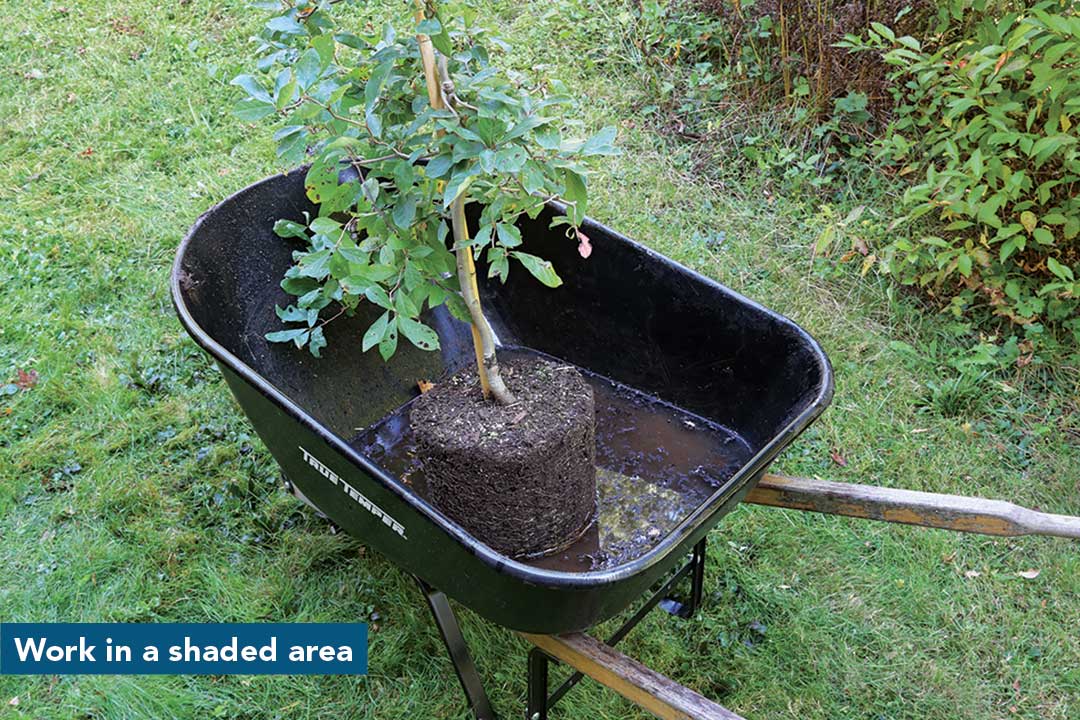
1. Work in a cool, shaded area with access to water. Once root washing begins, the roots will need to be kept constantly moist. Remove all foreign material from the root ball—containers, twine, burlap, wire baskets—before washing. Gently shake off as much media as you can.
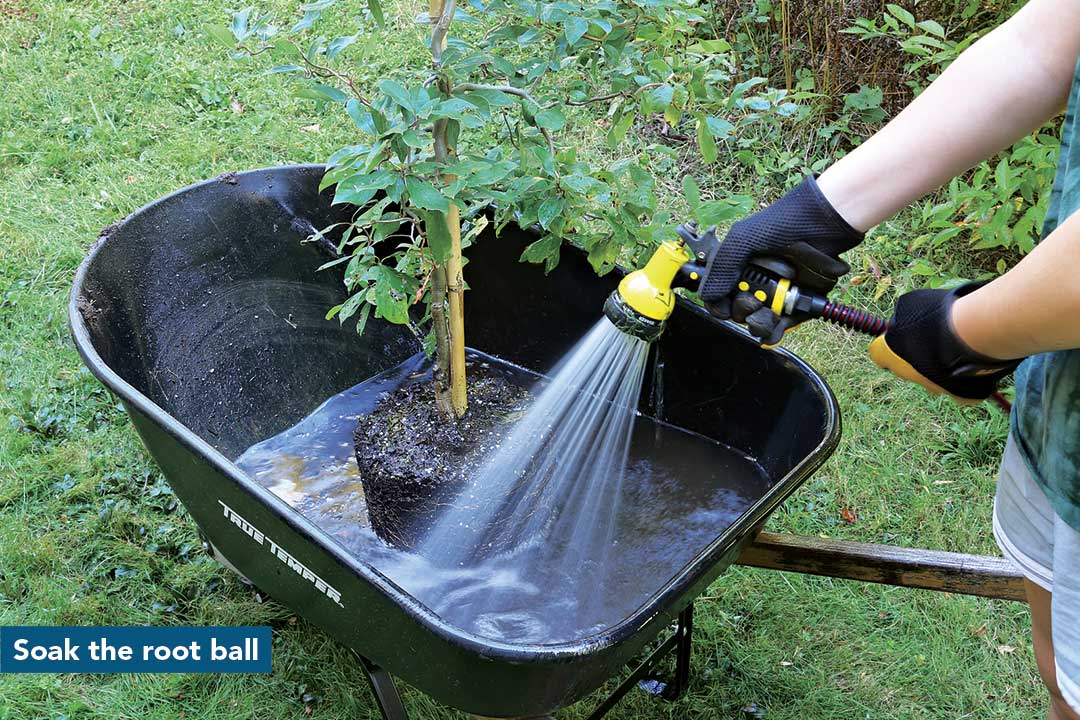
2. Place the root ball in a wheelbarrow, watering trough, or other large container with enough water to cover the ball completely. Do not allow any part of the ball to dry out. You can leave it here for several hours if necessary. Soaking will hydrate the media, allowing it to be more easily removed.
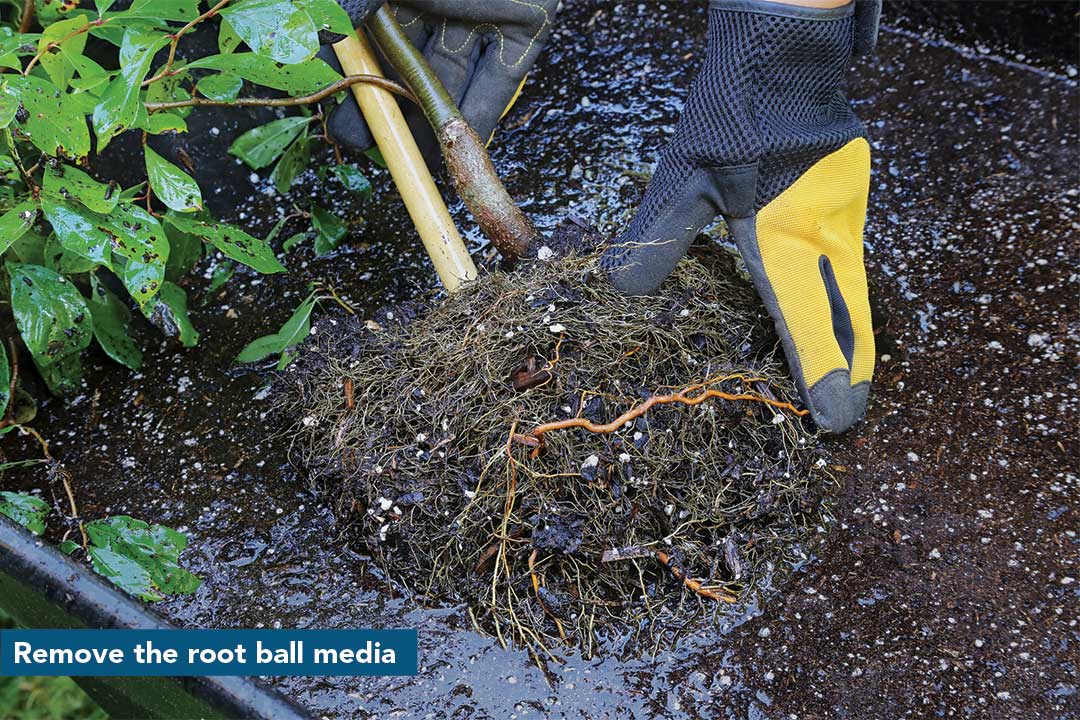
3. Using your fingers or a stream of water, remove as much of the root ball media as you can. Return for more soaking if needed.

4. Once you can see the root system, you can correct poor root structure. Roots should spread outward from the base like spokes on a wheel. Prune any woody roots; fibrous roots can be straightened out by hand during planting.
5. Dig a hole that is no deeper than the root mass and at least as wide as the root mass. The hole will be wide and shallow.
6. Place the roots in the hole, covering with native soil as you go. Once the soil is in place, soak the roots completely with water until saturated. If air pockets develop, add more soil. Do not press down on the soil at any point. Let gravity do the work of soil placement.
7. Mulch the planted area with a layer of arborist wood chips at least 4 inches thick. The wider this this circle is, the better it is for tree establishment.
Linda Chalker-Scott is an extension urban horticulturist at Washington State University and the author of How Plants Work.
Fine Gardening Recommended Products
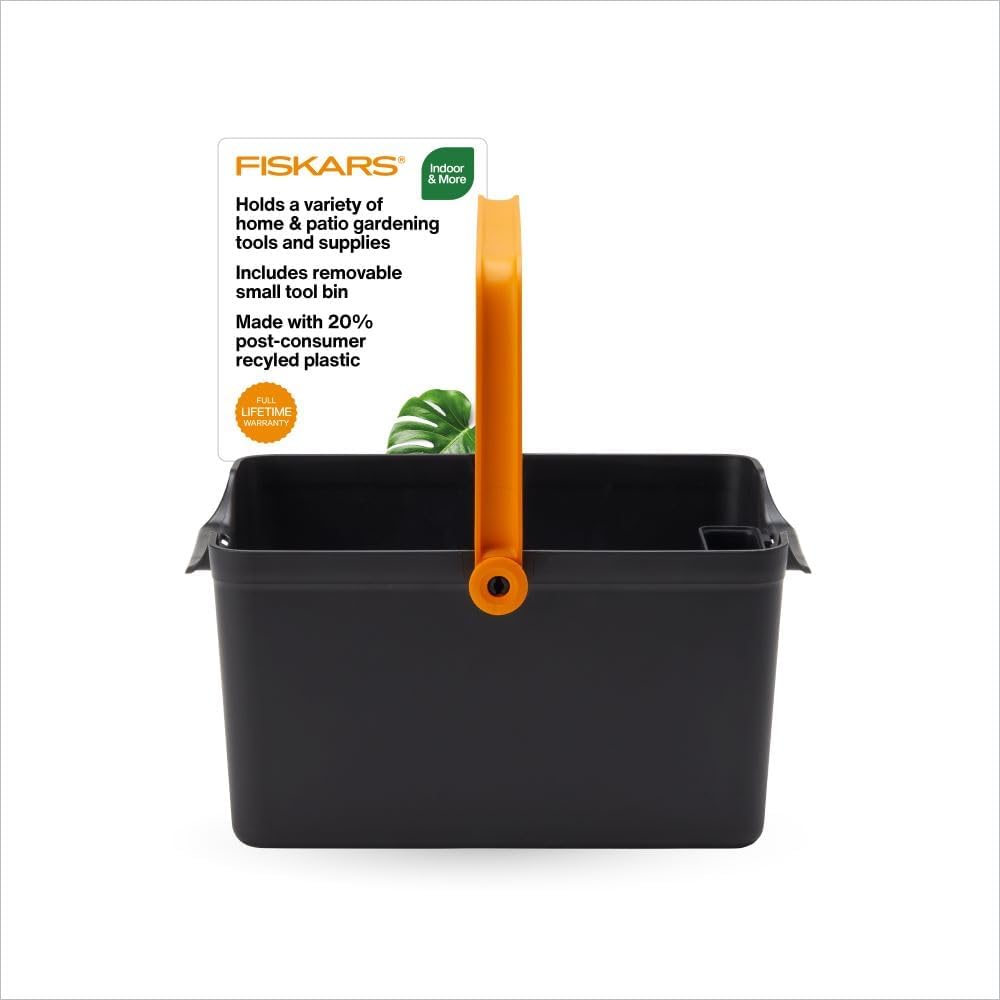
Fiskars Garden Tool Caddy with Removable Small Tool Storage for Indoor and Outdoor Gardening Use, Made with Recycled Plastic
Fine Gardening receives a commission for items purchased through links on this site, including Amazon Associates and other affiliate advertising programs.
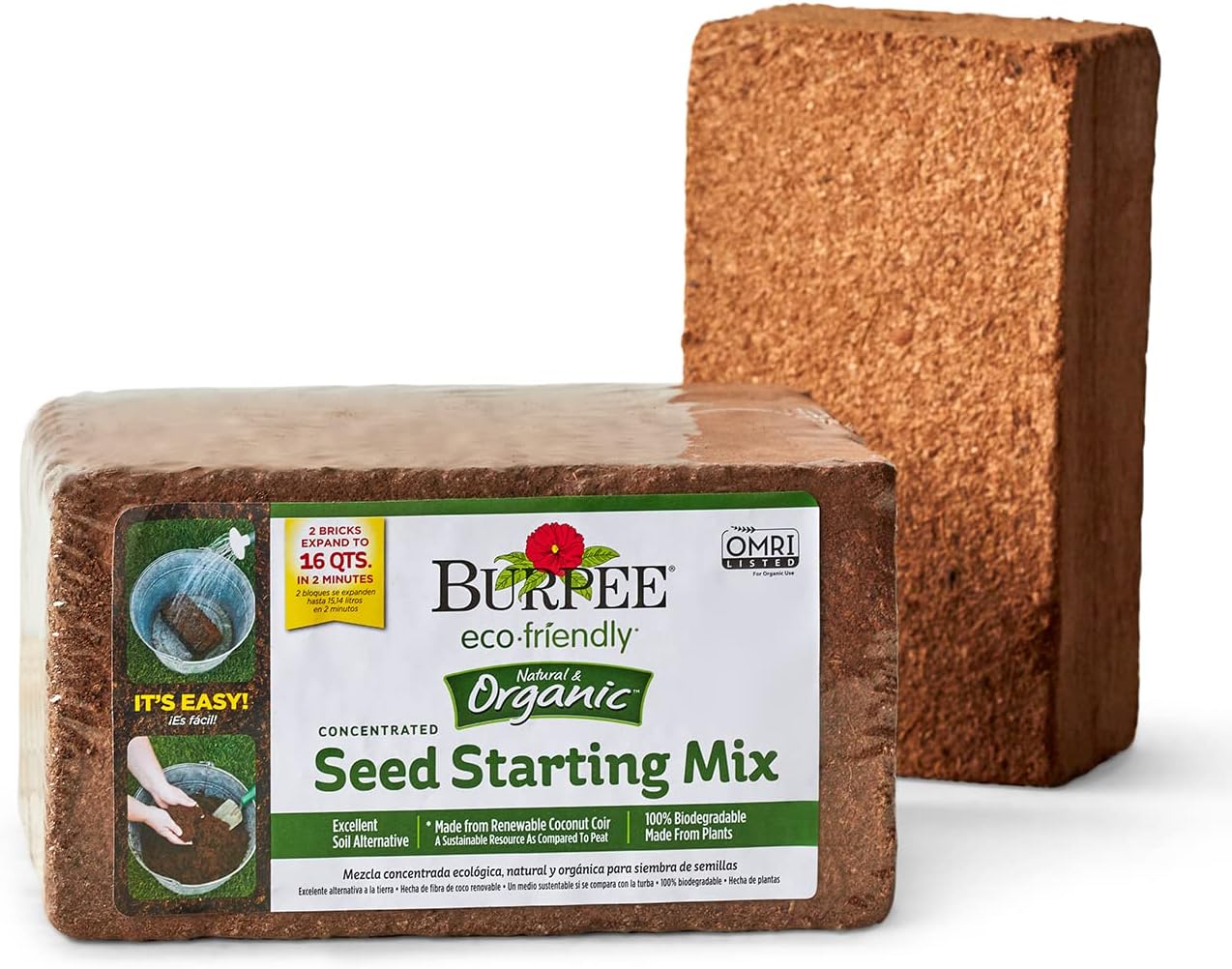
Burpee Organic Coconut Coir Concentrated Seed Starting Mix, 16 Quart
Fine Gardening receives a commission for items purchased through links on this site, including Amazon Associates and other affiliate advertising programs.

ARS Telescoping Long Reach Pruner
Fine Gardening receives a commission for items purchased through links on this site, including Amazon Associates and other affiliate advertising programs.



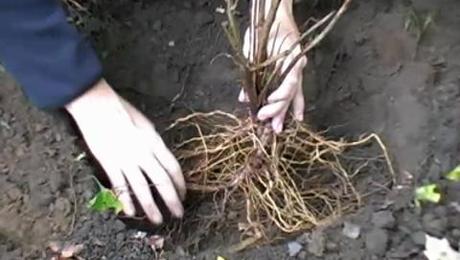














Comments
please consider adding a note about keeping mulch away from the trunk (maybe, also keeping the root flare visible)… around here, the mulch is piled 10” high around the trunk like a giant ant hill.
also… GREAT article. May I share this with our forestry department?
Log in or create an account to post a comment.
Sign up Log in